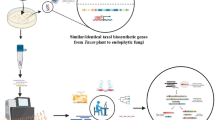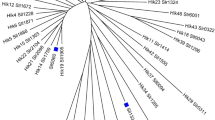Abstract.
Terpenoids or isoprenoids constitute a vast family of organic compounds that includes sterols and carotenoids. The terpenoids in many organisms share early steps in their biosynthesis, including the synthesis of 3-hydroxy-3-methylglutaryl-coenzyme A (HMG-CoA) and its conversion to mevalonate. We have cloned and characterised the genes hmgS for HMG-CoA synthase and hmgR for HMG-CoA reductase from the Zygomycete Phycomyces blakesleeanus. Single copies of these genes are present in the Phycomyces genome. The predicted product of hmgS is largely hydrophilic and that of hmgR has eight putative transmembrane segments and a large hydrophilic domain. The hydrophilic domain suffices for catalytic activity, as shown by expressing it in Escherichia coli. Several features in the promoter of hmgS and in HMG-CoA reductase resemble motifs known to be involved in sterol-mediated regulation and sterol sensing. Carotene-overproducing mutants contain more hmgS mRNA than the wild type, possibly in response to an increased demand for HMG-CoA.
Similar content being viewed by others
Author information
Authors and Affiliations
Additional information
Electronic Publication
Rights and permissions
About this article
Cite this article
Ruiz-Albert, .J., Cerdá-Olmedo, .E. & Corrochano, .L. Genes for mevalonate biosynthesis in Phycomyces . Mol Gen Genomics 266, 768–777 (2002). https://doi.org/10.1007/s004380100565
Received:
Accepted:
Issue Date:
DOI: https://doi.org/10.1007/s004380100565




